Text

Summer-Love
Image generated with SD-1.5, overworked with inpainting and composing.
#gaycouple#gayart#relaxinglove#boyfriend#boylovesboy#gaylove#LGBT#springlove#boys#summerlove#muscles#friendship#hairyman#cuddlecare
7 notes
·
View notes
Text

The Minoan Civilization: An Early Example of Advanced Culture on Crete
The Minoan civilization, named after King Minos, a figure from Greek mythology, experienced its peak on the island of Crete from about 2000 to 1450 BCE. This culture is often regarded as one of the first advanced civilizations in Europe and exhibited remarkable liberalism and progressiveness, which were evident in many aspects of their society.
Cultural and Social Achievements
The Minoan society was characterized by its open and progressive attitude, as seen in the splendor of its architectural works, such as the richly decorated palaces, and in its art, exemplified by detailed frescoes and intricate jewelry. The artistic representations, including images of women in airy garments and men ritually leaping over bulls, illustrate a culture that highly valued physicality and aesthetic expression.
Progressive Views on Love and Relationships
A particularly striking feature of the Minoan civilization was its attitude towards homoerotic and homoromantic relationships. Compared to other ancient cultures, where such relationships were often taboo, artistic and ritualistic depictions suggest that in Minoan society, love and erotica in various forms were recognized and possibly celebrated. This openness is a testament to the liberal stance of the Minoans.
Economic Foundations and Trade Relations
The economy of the Minoan civilization was heavily influenced by trade. The Minoans maintained extensive trade contacts with other cultures of the Mediterranean, which not only increased their wealth but also promoted cultural exchange. Unlike many contemporary cultures that expanded through military conquests, the Minoans were primarily known as traders rather than warriors. These trade relationships supported a society that focused more on cultural development and economic exchange than on warfare.
Influence on Subsequent Cultures
The Minoan culture likely had a profound impact on later Greek culture. Elements of their art, architecture, and religious practices can be seen in Greek culture, indicating a strong cultural connection. These legacies show that the Minoans left a significant mark not only in their own time but also in the broader sweep of history.
In summary, the Minoan civilization was an impressive example of a liberal and progressive society that was ahead of its time in many areas. Its cultural achievements, particularly in art and economics, as well as its open social structures and attitudes, make it a fascinating subject of study in the history of human civilizations.
Text supported by Chat GPT-4
Base images generated with DALL-E, overworked with SD-1.5/SDXL inpainting and composing.
#MinoanCivilization#AncientCrete#Archaeology#HistoricalSociety#LiberalCivilizations#ArtHistory#AncientEconomics#CulturalDevelopment#GreekCulture#HistoricalImpact#gayart#queer#manlovesman#LGBT#gaylove#homoromantic
17 notes
·
View notes
Text
Summer is coming, and the boys are out again.
Image generated with a depth map of a 3D render in StableDiffusion 1.5 overworked with inpainting and composing

6 notes
·
View notes
Text
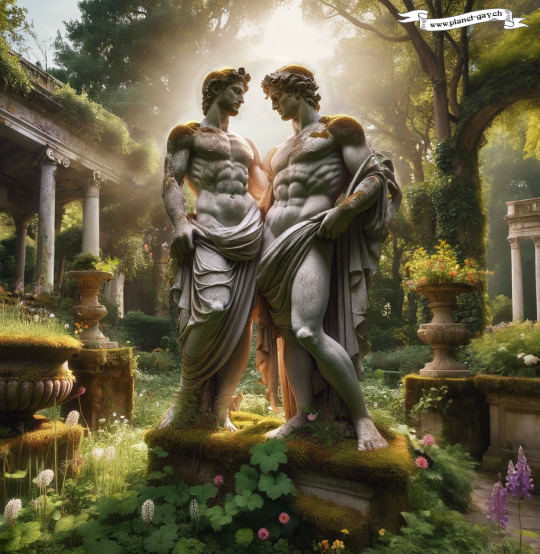
Abandoned Roman Villas (Part II)
As the Roman Empire faced its decline in the 5th century, it left not only political and cultural imprints but also its stately villas, which were gradually reclaimed by nature. These abandoned monuments caught the interest of the Norse and Germanic peoples as they moved through their new territories.
For the Norse peoples, who lived in a world shaped by nature where belief and myth were closely intertwined, the abandoned Roman estates must have appeared mystical and almost surreal. The magnificent buildings, standing amid wildly overgrown gardens and crumbling walls, were like windows to another world—a world left behind by the Romans, whose way of life was fundamentally different from that of the Germanic and Norse peoples.
The ruins were likely seen as places of great power and magic. Norse legends and traditions that deal with decayed structures often speak of "enchanted places" where the spirits of the past are still palpable. The villas might have been regarded by the Norse as magical sites inhabited by the spirits of the Roman nobility who once populated these halls.
Reports from this era are sparse, but it is likely that the Norse interpreted the Roman statues and artworks they found as representations of Roman gods and mythological scenes that were foreign to them. These artifacts may have been treated with reverence or even seen as potential relics or talismans that could offer power or protection.
The rapid reclamation of the villas by nature could also have been seen as symbolic of the victory of the 'wild' natural order over the 'civilized' Roman one. This fits well with the Norse view of nature as a central, life-giving, and sometimes destructive force.
While there are no concrete historical records of the Norse peoples' thoughts on the specific villas, we can speculate that these places were viewed as magical, eerie, and inhabited by spirits. The abandoned Roman villas were not only silent witnesses to past glory but also canvases for the mythologies and cultural expressions of the new 'owners' of these lands.
Overall, the ruins of the Roman villas provided the Norse and Germanic peoples with plenty of reasons for awe and speculation and were likely regarded as significant cultural and spiritual sites where the past and present mysteriously converged. These encounters with the remnants of Roman civilization may have contributed to a rich layer of myths and legends that shaped the Norse culture and its relationship with the past.
Text supported by Chat GPT-4
Base images generated with DALL-E, overworked with SD-1.5/SDXL inpainting and composing.
#AbandonedVillas#RomanEmpire#NorseMythology#CulturalHeritage#HistoricRuins#NatureReclaims#MythAndLegend#SpiritualSites#AncientCivilizations#CulturalConvergence
4 notes
·
View notes
Text

The Decline of the Roman Empire and the Forgetting of Roman Villas
Throughout the 5th century, the once mighty Roman Empire experienced a series of political, economic, and military crises that ultimately led to its downfall. It is this era of transition and decay during which the magnificent Roman villas were abandoned and reclaimed by the relentless force of nature.
The fall of the Western Roman Empire was not an abrupt event but the result of a lengthy process accelerated by various factors. Among these were economic stagnation, characterized by a declining trade network and a shrinking tax base. Additionally, political unrest, civil wars, and the erosion of state structures contributed to the weakening of central power.
Another decisive factor was the migration period, a time of intense migration of various Germanic and other tribes, partly due to population pressure and climate change, and partly attracted by Rome's wealth. The Goths, Vandals, Franks, Lombards, and many other groups crossed the borders and settled on Roman territory, often leading to conflicts and looting.
The Roman villas, once symbols of wealth and cultural life, were frequently abandoned during this time. Many of the aristocratic owners fled to the safer cities or were driven away by the invading tribes. Without their owners and the slaves or tenants who worked and maintained the land, the buildings quickly fell into disrepair.
Nature swiftly took over the deserted places. The carefully maintained gardens of the villas became overgrown, as there was no one left to trim and shape them. Native plants and trees overran the intricate mosaics and impressive statues, while climbing plants entwined the once proud columns, undermining the structure of the buildings.
Archaeological finds from this period give us a glimpse into the slow process of decay. Mosaics under the root work, statues half buried in the ground, and hoards of coins buried in haste tell the story of a bygone era of splendor and subsequent forgetting.
The decay of the Western Roman Empire and the abandonment of the Roman villas mark the end of antiquity and the beginning of the Early Middle Ages in Europe. The overgrown ruins of these villas are silent witnesses to the once Roman heritage and the unstoppable force of nature, which ultimately always reclaims its space. They remind us of the transience of human works and the incessant course of history.
The story of the decline of the Roman Empire and the associated return of nature over the abandoned villas has remarkable relevance today. It reminds us of the fragility of human civilizations and how quickly nature can take over human-made structures once conservation efforts wane. This theme is particularly resonant at a time when global challenges such as climate change, environmental destruction, and socio-economic upheavals are at the forefront.
The ruins of the Roman villas can be seen as a metaphor for the need to protect our environment and live sustainably to prevent our own "villas" – our cities and communities – from similarly decaying one day. They also caution us that, despite the apparent permanence of our modern world, we too are vulnerable to the forces of change and time.
History offers us lessons on the importance of adaptability, resilience, and the necessity to preserve the environment we live in. It also shows how cultural and historical sites can be lost over time if not actively protected and maintained. In a broader context, it encourages reflection on how we preserve our history while simultaneously shaping a sustainable future.
Text supported by Chat GPT-4
Base images generated with DALL-E, overworked with SD-1.5/SDXL inpainting and composing.
#RomanEmpire#ForgottenVillas#AncientRuins#NatureReclaims#HistoryLessons#Sustainability#CulturalHeritage#lostgarden#romantic#statues
2 notes
·
View notes
Text
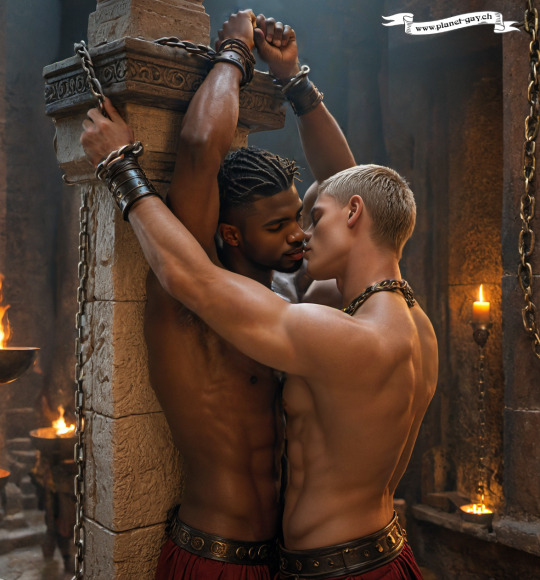
United by Fate
Sometimes it's the chains of fate that unexpectedly bring us closer together. In encountering the other, in confronting what appears foreign, lies the opportunity to overcome prejudices and to realize that it is precisely our differences that enrich the mosaic of human relationships. In conflict, we often discover an unexpected closeness, a depth in relationships that is forged in the fire of conflict and welded together by fate.
Transformation work from an an older pictures depth map made with Poser-3D and G2M Figures over ControllNetV1.1.410 and AI inpainting and composing with SDXL.
#UnitedByDestiny#HumanConnections#OvercomingPrejudice#UnityInDiversity#BondsOfFate#OppositesAttract#gayart#gaylove#lgbt#bdsm#inchain#fate
26 notes
·
View notes
Text
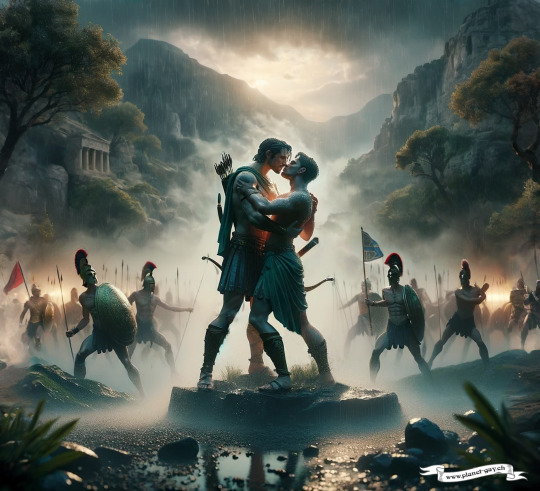
When Love Defies Battle Lines the battle take a surprising turn.
Image generated with DALL-E, overworked StableDiffusion SDXL-1.0 (DreamDiffusionXLSD) with inpainting and composing.
#LoveOverWar#BattlefieldRomance#WarriorLove#Peace#ErosAndAres#LoveDefiesConflict#MythicalMoments#LoveInTheTimeOfBattle#WarriorKiss#gayart#queer#lgbt#manlovesman#mankissman
7 notes
·
View notes
Text

The Egg Hunting goes on...
Image generated with StableDiffusion 1.5 overworked with inpainting and composing.
#LoveInSpring#EasterMonday#EasterJoy#SpringCelebration#EasterEggs#BunnyLove#gayart#queer#hotboy#hotman#egghunting#muscleman
20 notes
·
View notes
Text

Spring Awakening
Out of the grey winter slumber and finally back into the warm nature where the flowers awaken and the hormones dance. Ready for new adventures in love, sports, and summer fun.
Image generated with DALL-E, overworked StableDiffusion SDXL-1.0 (DreamDiffusionXLSD) with inpainting and composing.
#SpringAwakening#NatureReborn#LoveInSpring#EasterSunday#EasterJoy#SpringCelebration#EasterEggs#BunnyLove#ChocolateEggs#gayart#queer
4 notes
·
View notes
Text

Good Friday and Easter: A Cycle of Death and Rebirth
In the heart of spring, Good Friday and Easter stand as a duo, unified by their contrasts. The silence and sorrow of Good Friday lead us to the joyous celebration of Easter Sunday, a time that celebrates life and hope. These holidays symbolically represent the eternal return, the renewal of life, and the triumph of light over darkness.
From Pagan Spring Rituals to the Christian Festival of Hope:
Easter, the focal point of the church year, is closely tied to the resurrection of Christ. Yet, its roots reach deep into history, to times when spring was honored through pagan festivals that celebrated the cycle of death and rebirth in nature. This piece delves into the history and significance of Easter, highlighting how it has evolved over time.
Celebrating Spring Since the Dawn of Humanity:
Since prehistoric times, people have marked the arrival of spring with festivities that reflected the cyclical nature of life and themes of death and rebirth. These early celebrations were brimming with vitality, signaling the end of winter and the reawakening of nature.
Transformation Through Christianity: Between Good Friday and Easter
As Christianity spread, many of these pre-Christian customs were adapted. The focus shifted to the story of Jesus' crucifixion and resurrection, turning Good Friday and Easter into symbols of death and new life, two sides of the same coin, emphasizing the profound meaning of loss and rebirth.
The Deeper Symbolism:
Good Friday, a day of pause and reflection, paves the way for Easter Sunday, a festival of joy and victory. These contrasts illustrate the eternal cycle of life: darkness gives way to light, sorrow to joy, and from death springs new life. These themes are found worldwide in various cultures and religions, reflecting the human longing for renewal and liberation.
The Relevance of Good Friday:
In many Christian traditions, Good Friday is a deeply spiritual day, marked by prayer and contemplation. Despite its contrast to the festive Easter, it is an essential part of the Easter tradition, symbolizing the emotional and spiritual journey from darkness to light, from death to new life.
The Cosmic Connection:
Interestingly, the period of Good Friday and Easter often coincides with the transition from the Pisces to Aries zodiac signs, forming an intriguing contrast: Pisces represent conclusion and letting go, Aries beginnings, energy, and determination. This astrological phase mirrors the themes of Easter, providing an additional layer of interpretation.
Text supported by Chat GPT-4
Images generated with SD-1.5, overworked with inpainting and composing.
#GoodFriday#Easter#Rebirth#Spring#Christianity#PaganTraditions#Renewal#Hope#Spirituality#CulturalTraditions#AstrologicalSigns#gayart#consolation#comfort
12 notes
·
View notes
Text

Make Love not War
Images generated with DALL-E, overworked StableDiffusion SDXL-1.0 (DreamDiffusionXLSD) with inpainting and composing
38 notes
·
View notes
Text
Deep Love and Connection

In ancient Greece, love was not bound by gender but by the beauty of the connection between two souls. This culture did not know our modern terms of homosexuality or heterosexuality. Rather, love was experienced as a multifaceted spectrum that could include all people.
Especially in the world of warriors, this freedom of emotional bonding was pronounced. The famous Sacred Band of Thebes consisted of pairs of men of the same age, whose mutual love was considered a source of their strength. Their bonds were not only strategic in nature but also deeply emotional. Such relationships were publicly acknowledged and respected, as they were seen as an expression of the highest virtue and harmony.
In the education of young men, pederasty was a socially recognized form of relationship between an adult man and a male youth in ancient Greece. These relationships often had an educational component and were an important part of the social structure. Peer-aged pairs were also common. It was a world where men could freely express their affection and admiration for one another without the strict labels that later emerged.
The ancient stories of Achilles and Patroclus or of Alexander the Great and Hephaistion offer examples of profound bonds between peer-aged warriors. The martial culture of ancient Greece, where strength and virtue were highly valued, provided fertile ground for the emergence of such deep emotional connections. For a warrior, the companion at his side was not just a fellow combatant in battle but also a partner in life, with whom all joys and sorrows were shared.
In our modern world, where we still struggle for acceptance, these ancient traditions remind us that love in human history has always been complex and boundless. It awakens in us the memory of a time when love was free from prejudice and definitions and celebrated for what it truly is: a deep connection between people.
Text supported by Chat GPT-4
Images generated with SD-1.5, overworked with inpainting and composing.
#hashtags#DeepLove#Connection#AncientGreece#SacredBandOfThebes#Pederasty#Achilles#Patroclus#AlexanderTheGreat#Hephaistion#LoveBeyondLabels#gayart#gaylove#manlovesman#muscles#washbaoardabs
24 notes
·
View notes
Text
Give me your hand!

Images generated with DALL-E, overworked StableDiffusion SDXL-1.0 (DreamDiffusionXLSD) with inpainting and composing
12 notes
·
View notes
Text
Knight and Squire

Created with a mix of 3D rendering and AI inpainting and composing with SD 1.5/SDXL
28 notes
·
View notes
Text
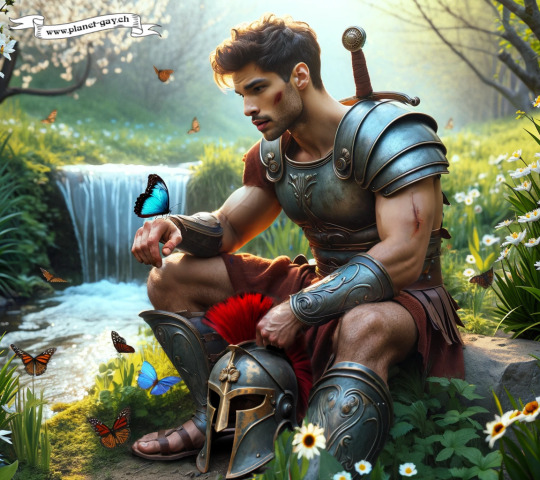
The Warrior and the Butterfly
It's not the grand triumphs or the shining victories that define the essence of the human spirit, but rather the small moments of joy and wonder that find their place even in the darkest times. Like a warrior who, despite the scars of battle, admires the grace of a butterfly, so too can we master the art of finding delight in the simple, precious things of life amidst the greatest crises.
It is the ability of humanity to find joy in the simplest and tenderest things amidst tragedy that demonstrates its strength and humanity. The butterfly becomes a symbol of hope, a beam of light in the darkness that comforts the warrior and gives him the strength to keep fighting, not only for victory but for the beauty of nature and the value of life itself.
Text supported by Chat GPT-4
Images generated with DALL-E, overworked StableDiffusion SDXL-1.0 (DreamDiffusionXLSD) with inpainting and composing.
#Butterfly#HumanSpirit#Hope#NatureBeauty#LifeValue#gayart#spring#gaywarrior#ancientwarrior#man#muscle#landscape#relax#flowers#meadow#lgbt#beauty
24 notes
·
View notes
Text
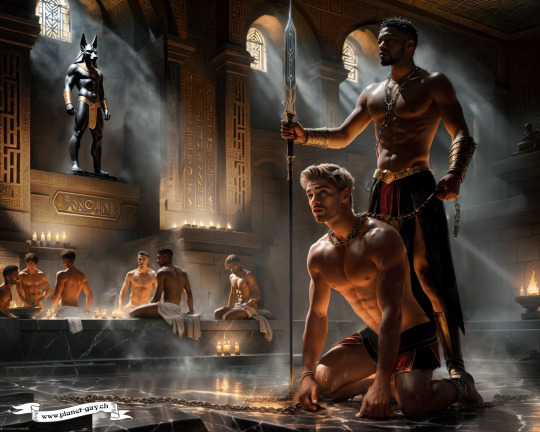
Anusbis's Harem Boys (Towel Version)
"Yes, you are a good boy for my Harem!"
97 notes
·
View notes
Text

The Artnouveau Spring Bathroom
Base images generated with SD-1.5, overworked with SDXL / SD-1.5 inpainting and composing.
83 notes
·
View notes